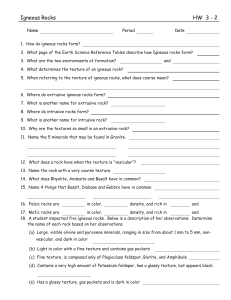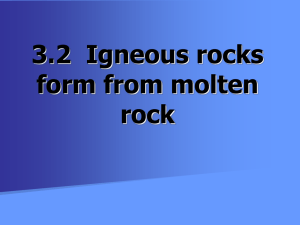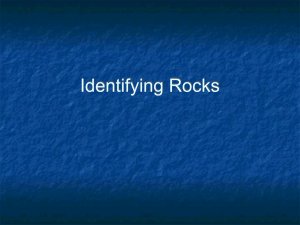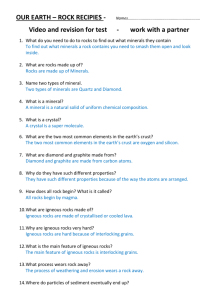Earthscomp_structureigneous rocks_berumen
advertisement
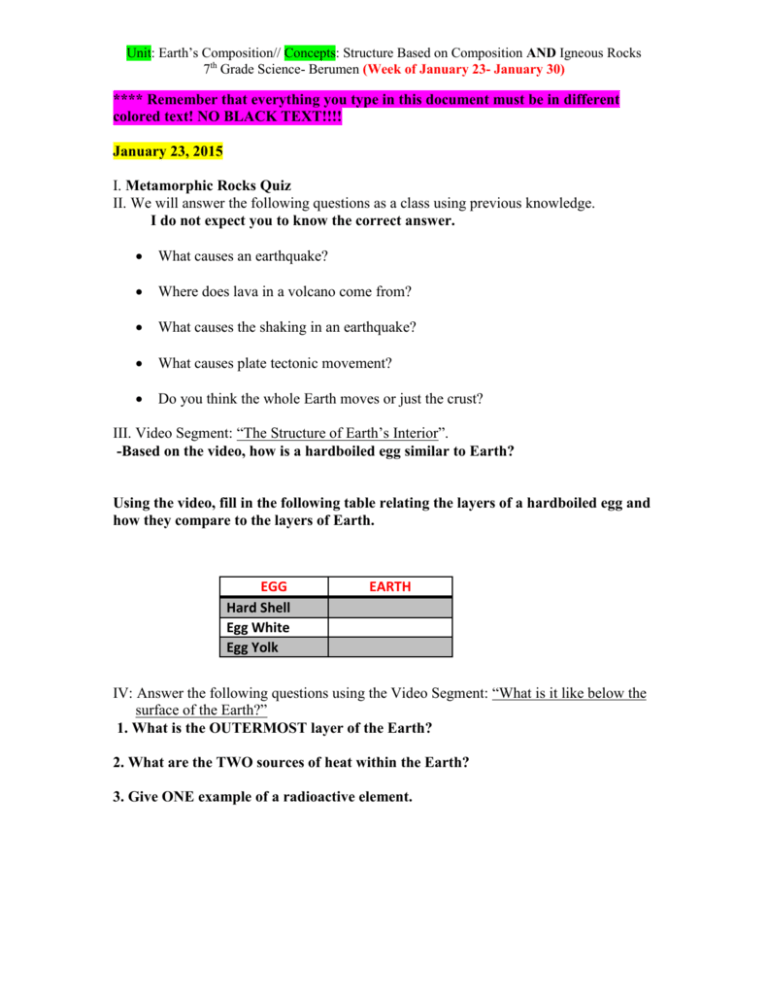
Unit: Earth’s Composition// Concepts: Structure Based on Composition AND Igneous Rocks 7th Grade Science- Berumen (Week of January 23- January 30) **** Remember that everything you type in this document must be in different colored text! NO BLACK TEXT!!!! January 23, 2015 I. Metamorphic Rocks Quiz II. We will answer the following questions as a class using previous knowledge. I do not expect you to know the correct answer. What causes an earthquake? Where does lava in a volcano come from? What causes the shaking in an earthquake? What causes plate tectonic movement? Do you think the whole Earth moves or just the crust? III. Video Segment: “The Structure of Earth’s Interior”. -Based on the video, how is a hardboiled egg similar to Earth? Using the video, fill in the following table relating the layers of a hardboiled egg and how they compare to the layers of Earth. EGG Hard Shell Egg White Egg Yolk EARTH IV: Answer the following questions using the Video Segment: “What is it like below the surface of the Earth?” 1. What is the OUTERMOST layer of the Earth? 2. What are the TWO sources of heat within the Earth? 3. Give ONE example of a radioactive element. Unit: Earth’s Composition// Concepts: Structure Based on Composition AND Igneous Rocks 7th Grade Science- Berumen (Week of January 23- January 30) V: Vocabulary. Define the following vocabulary words using Discovery Education’s Interactive Glossary. Canyon Density Deposit Geology Lava Metal Ocean Rock layer Volcanic dome Volcano January 26, 2015 I. Bell Work 1 3 1. 7 ∗ 10 2 11 4 3 2. 9 ∗ 12 3. 5 ∗ 8 II. We will watch the video segments “What Is It Like Below the Surface of the Earth?” , “ AND the video segment “Earth” from (3:57-4:55). We will then use the information discussed in the video to take class notes. TWO TYPES OF LAYERS I. PHYSICAL LAYERSThey are called physical layers because they are _______, _______ and ________ There are _______ physical layers. Unit: Earth’s Composition// Concepts: Structure Based on Composition AND Igneous Rocks 7th Grade Science- Berumen (Week of January 23- January 30) Physical Layer Description Answer the following question in a complete sentence. **Why doesn’t the inner core of the Earth melt? II. EARTH’S COMPOSITIONAL LAYERS. -They are called compositional layers because -There are _________ compositional layers. Compositional Layer Description As a class we are going to read the “EXPLORE” tab of the concept “Structure based on Composition”. As we read the paragraphs, we will add more notes to our table. Unit: Earth’s Composition// Concepts: Structure Based on Composition AND Igneous Rocks 7th Grade Science- Berumen (Week of January 23- January 30) January 27, 2015 I. Bell Work 9 4 1. 11 ∗ 7 14 2 4 3 2. 27 ∗ 3 3. 7 ∗ 12 II. Log into Discovery Education, go to your “Science Techbook”. Click on the Unit “Earth’s Composition”, and on the concept “Structure Based on Composition”. Click on the “EXPLORE” tab, and click on the SECOND box on the left hand column titled “STRUCTURE OF EARTH”. Complete the exploration and the diagram below. TO FILL IN THE DIAGRAM, CLICK ON THE BLACK BOXES AND TYPE. Using all of the resources we have looked at the past couple days, including the “EXPLORE” tab, answer the following questions in complete sentences. 1. What are the compositional layers of Earth’s interior? 2. Describe the PHYSICAL layers of Earth (one sentence per layer). LithosphereAsthenosphereMesosphereOuter CoreInner Core- Unit: Earth’s Composition// Concepts: Structure Based on Composition AND Igneous Rocks 7th Grade Science- Berumen (Week of January 23- January 30) 3. Describe the COMPOSITIONAL layers of Earth (one sentence per layer). CrustMantleCore- The following statements are FALSE. Rewrite the sentence to make it true, or provide a description as to why the statement is FALSE. 1. Earth’s interior is made of solid rock. 1. Humans can drill into Earth’s core. 2. Lava erupting in volcanoes rises from Earth’s core. Unit: Earth’s Composition- Concept: Igneous Rocks Vocabulary: Define the following words using Discovery Education’s Interactive Glossary. Landform Magma Mantle Molten Prehistoric Pressure Superposition Unit: Earth’s Composition// Concepts: Structure Based on Composition AND Igneous Rocks 7th Grade Science- Berumen (Week of January 23- January 30) January 28, 2015 I. Bell Work 4 73 1. 9 ∗ 120 7 9 4 9 2. 15 ∗ 17 3. 11 ∗ 10 We will watch the video segment “Granite Rocks” and we will answer the following questions as a class. I do not expect you to know the answers to these questions yet. II. 1. How did the sediment that was deposited on the ocean floor millions of years ago turn into the granite rock that makes up most of Yosemite Valley? 2. Did the granite come from a volcano? 3. If the granite formed underground, how did it get to the surface? III. We will watch the first 3min and 53 seconds of the video segment “Magma Inside the Earth” and we will answer the following questions. 1. What is the difference between magma and lava? 2. What kind of rock forms when lava hardens? IV. Class Notes As a class we will read the reading passage uploaded on learn titled “Characteristics of Igneous Rocks”It is found under the “Structure & Igneous Rocks” folder. IGNEOUS ROCKS ARE classified by ______________ and _______________. Classifying Igneous rocks by texture Extrusive Intrusive Unit: Earth’s Composition// Concepts: Structure Based on Composition AND Igneous Rocks 7th Grade Science- Berumen (Week of January 23- January 30) Classifying Igneous Rocks by Composition - The four classifications of igneous rocks by composition are _____________, _____________, ______________ and ________________. - The two main classifications are ______________ and ________________. Felsic Mafic EQUIVALENT TERMS Terms used in classifying Igneous Rocks by TEXTURE Plutonic= Volcanic = EQUIVALENT TERMS Terms used in classifying Igneous Rocks by COMPOSITION Acid= Basic = January 29, 2015 I. Bell Work 9 3 1. 11 ∗ 7 2. 3. 4 19 14 15 6 ∗ 19 11 ∗ 18 II. We will watch the video segment “How are Igneous Rocks formed?” and answer the following questions. What is the process of crystallization? What is the difference between extrusive and intrusive igneous rocks? Give an example of an extrusive igneous rock. Unit: Earth’s Composition// Concepts: Structure Based on Composition AND Igneous Rocks 7th Grade Science- Berumen (Week of January 23- January 30) Give an example of an intrusive igneous rock. What are the two different types of weathering? III. “Chill Out, Rock On”. Assigned to you on Discovery Education is an exploration titled “Chill Out, Rock On”. Complete the exploration and fill out the table using your results. Magma Type Where Rock Formed Rate of Cooling Name of Rock Formed SCORIA BASALT GABBRO PUMICE RHYOLITE GRANITE IV. “Take me for Granite”. We will now read the reading passage uploaded on LEARN titled “Take me for Granite”. After we read the passage, you will write up a brief (4 sentence) description of HOW GRANITE CAN BE TRANSFORMED INTO SEDIMENTARY AND METAMORPHIC ROCK. January 30, 2015 I. We will watch the video segment “When Earth Erupts”. Using the video segment and other resources online, fill out the following table. Volcano Type Description (Shape, size, materials, eruption, and location) Shield Volcano Composite Volcano Unit: Earth’s Composition// Concepts: Structure Based on Composition AND Igneous Rocks 7th Grade Science- Berumen (Week of January 23- January 30) Cinder Cone Volcano II. Research: You will research why do some volcanoes have explosive eruptions, while others have relatively “quiet” eruptions? Give an example of volcano that has an “explosive eruption” Give an example of a volcano that has a “quiet eruption” MAKE SURE THAT YOU SHARE THIS DOCUMENT WITH ME BY FRIDAY, JANUARY 30TH, 2015!!!!!!!



